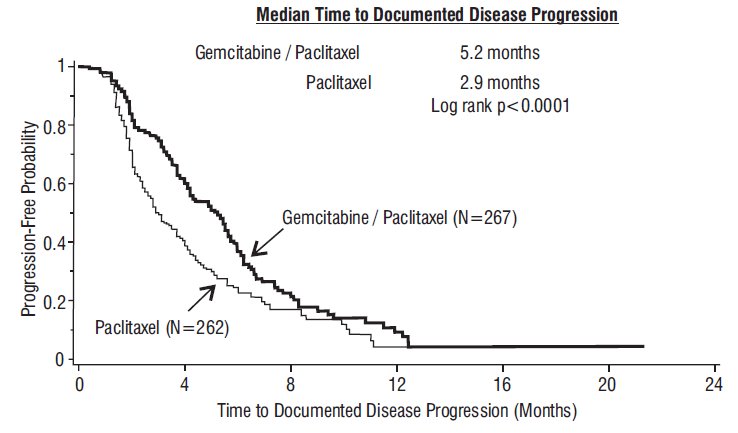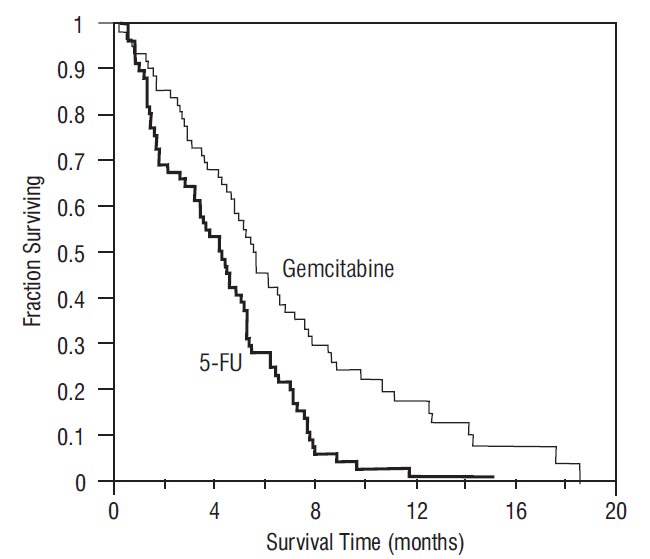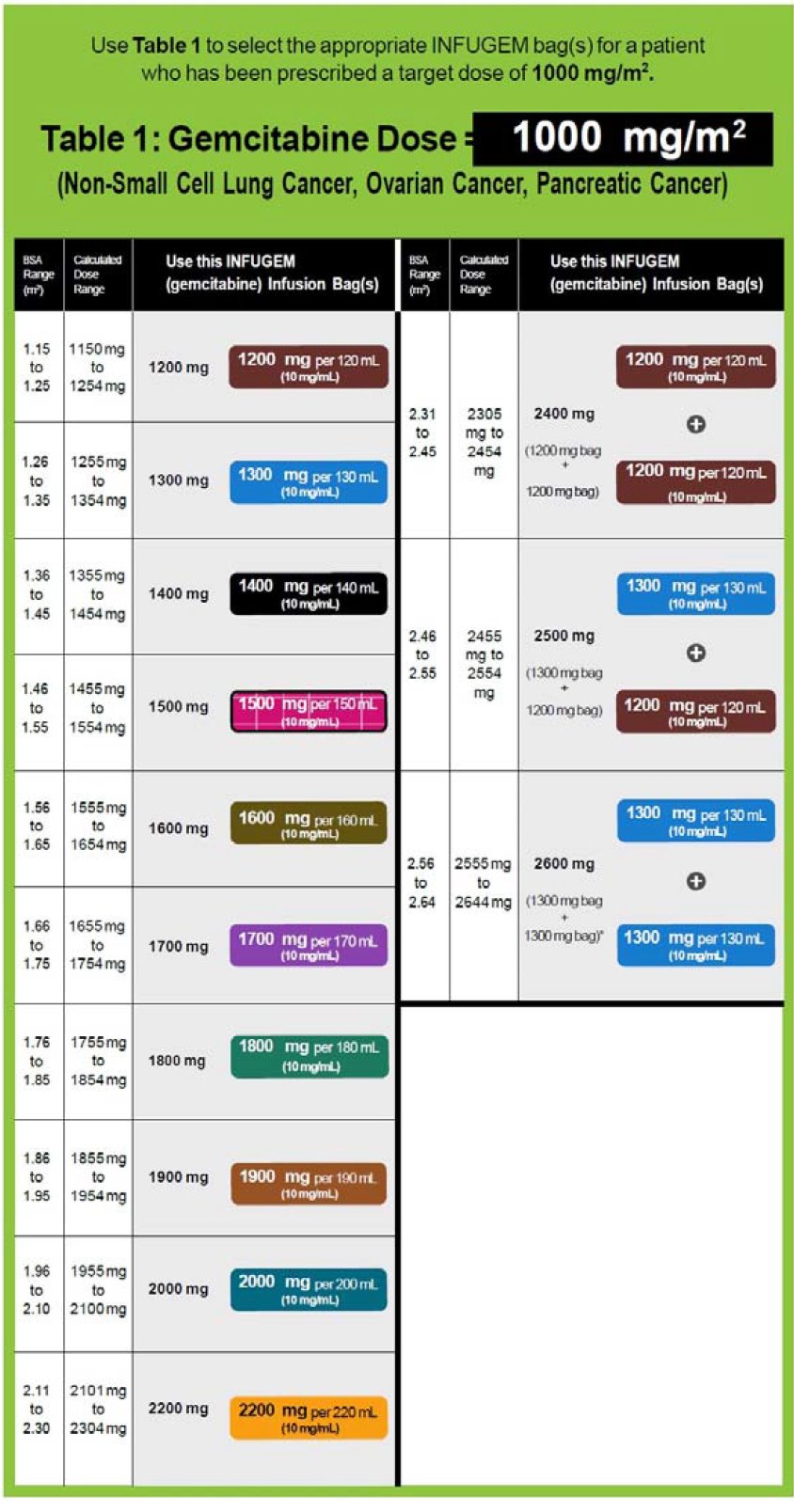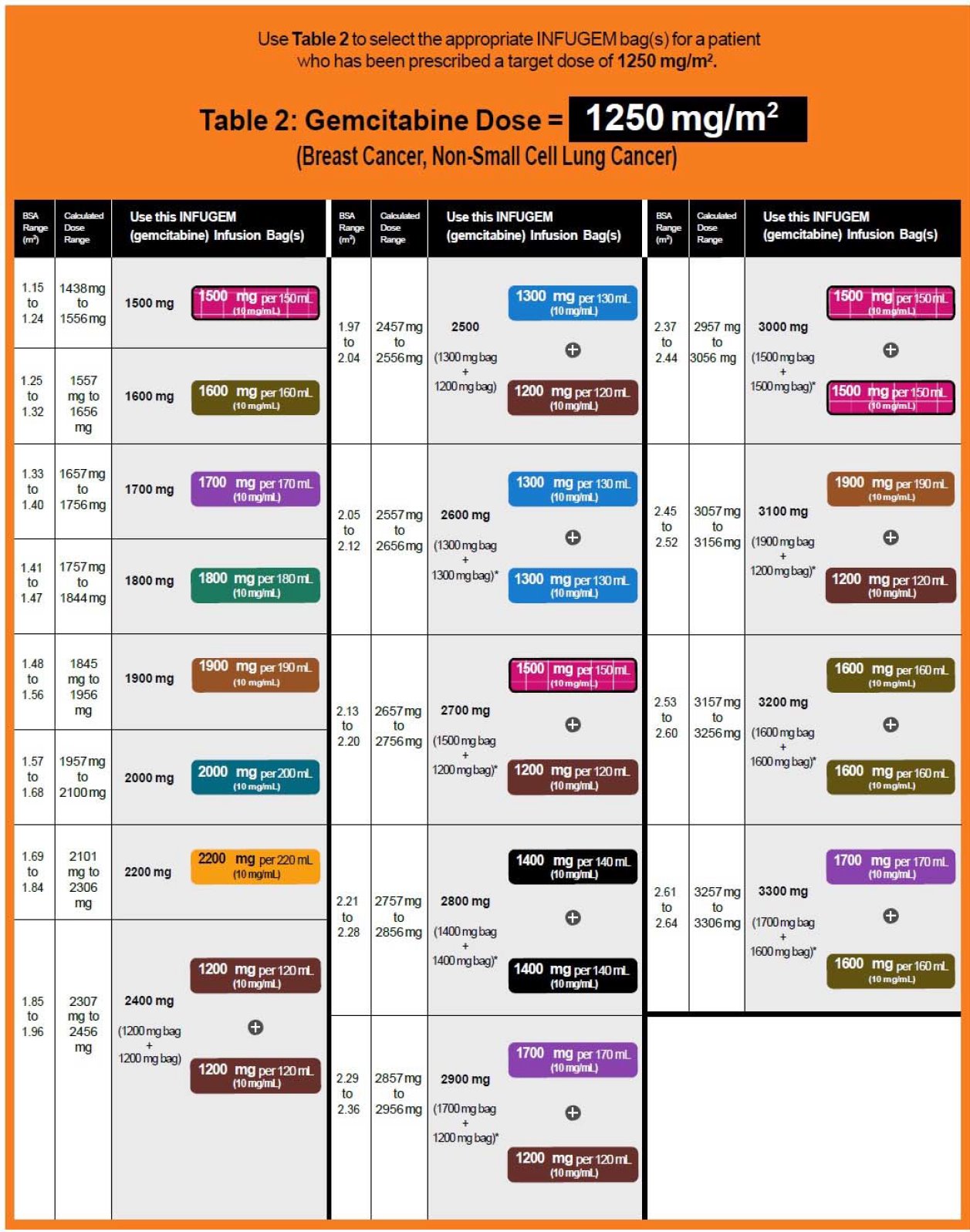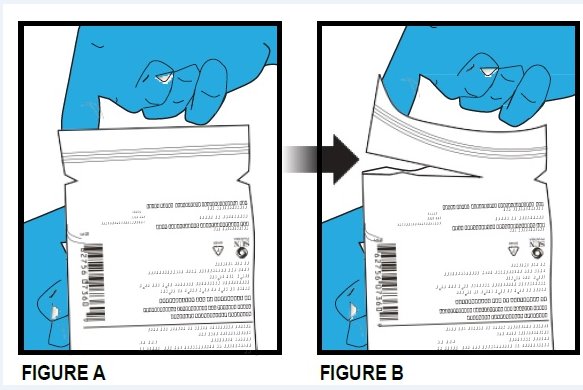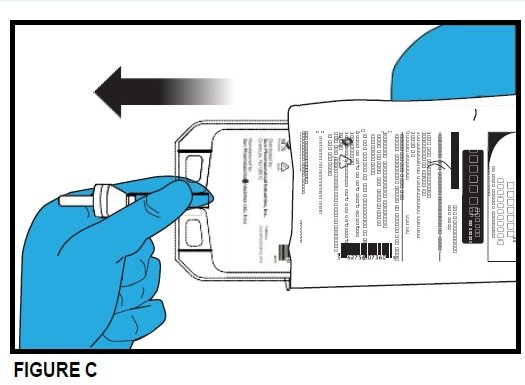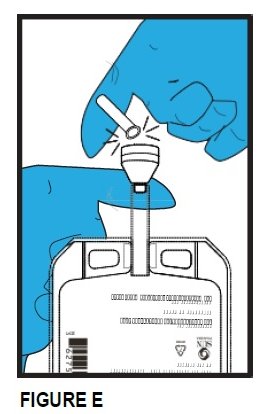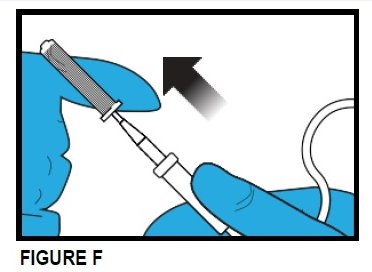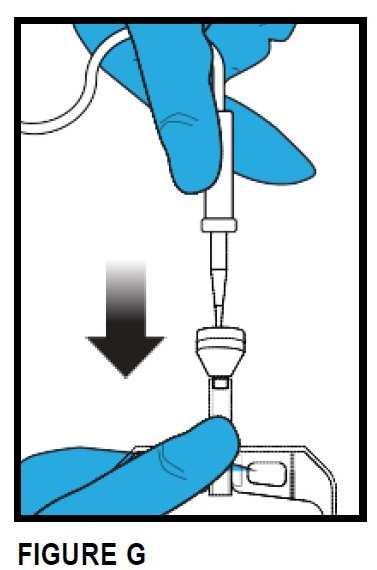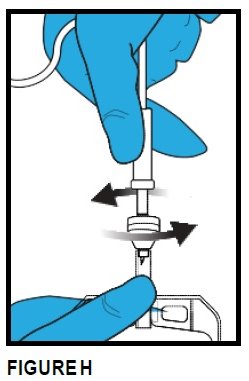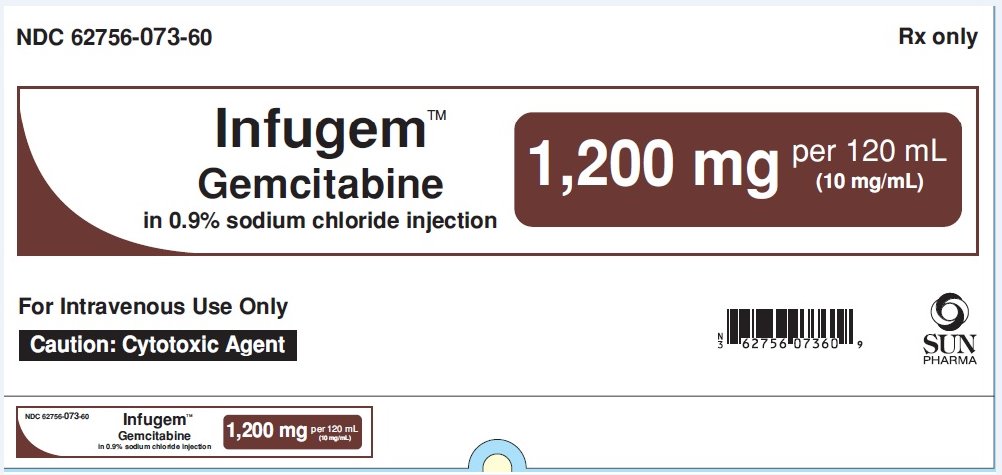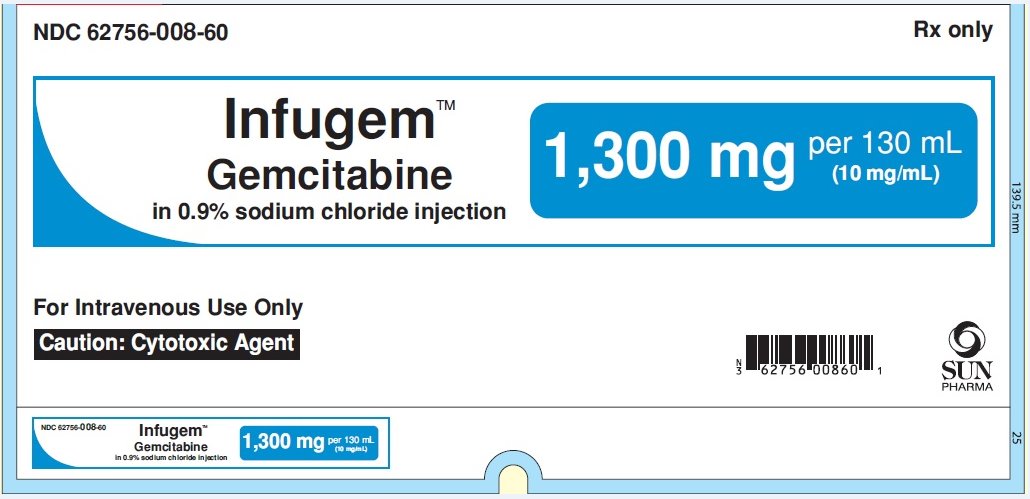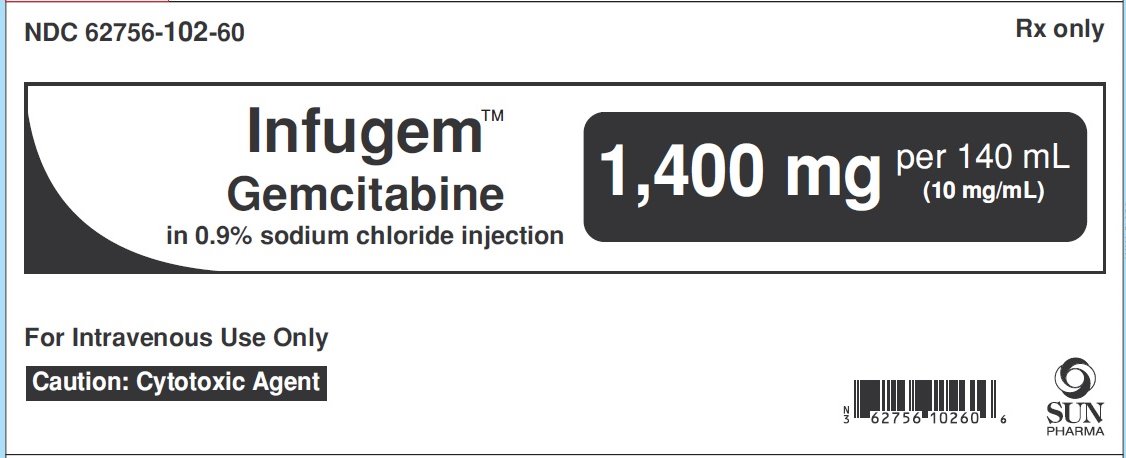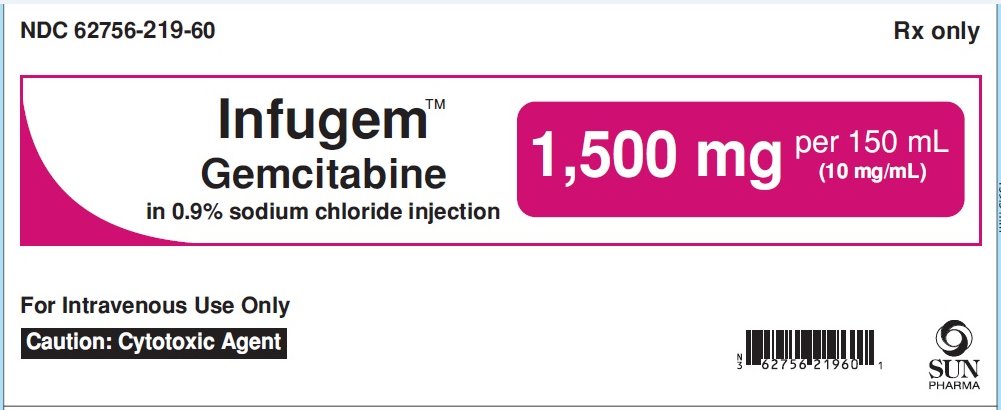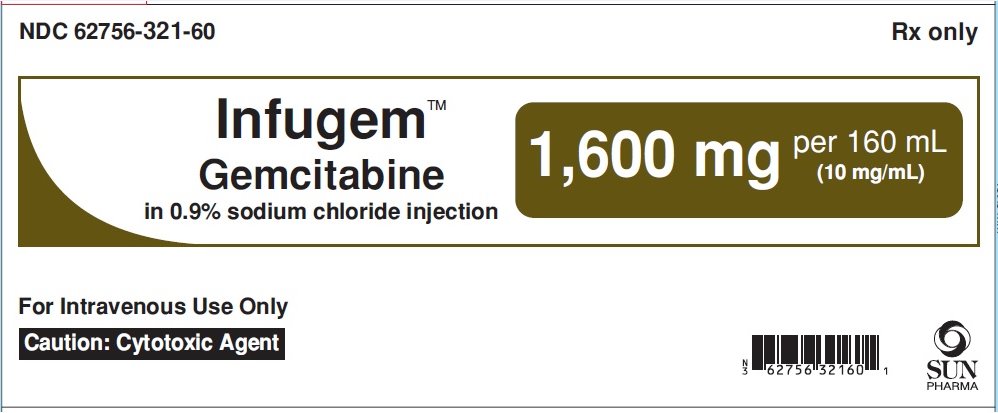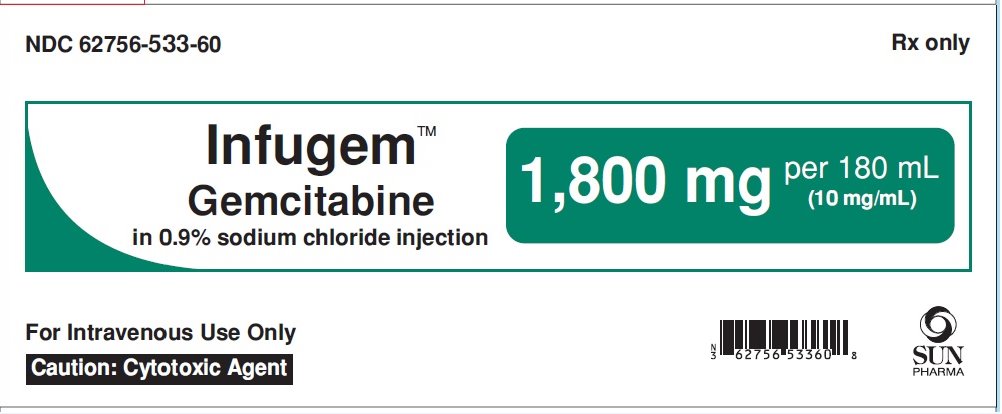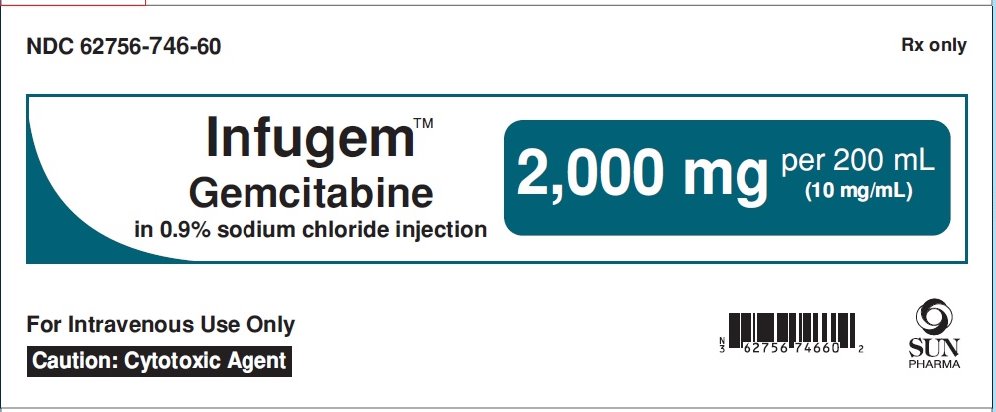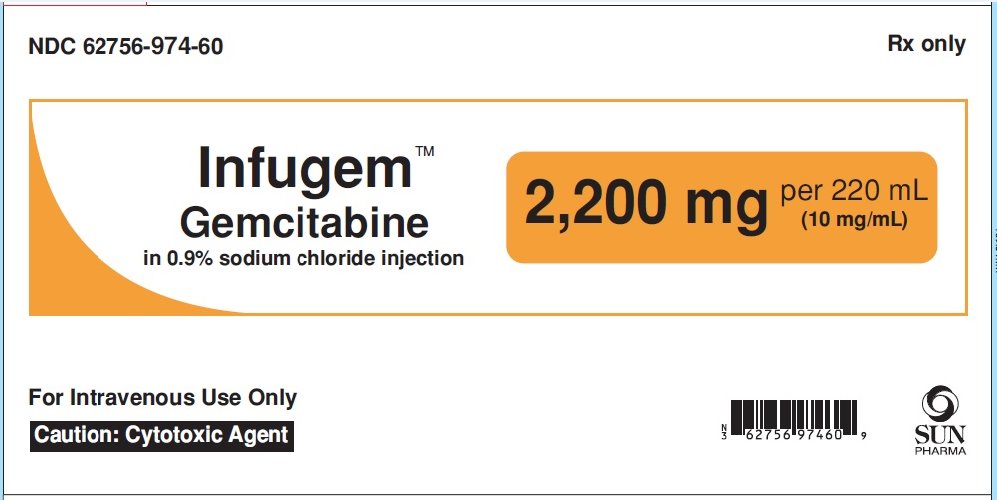INFUGEM- gemcitabine injection, solution
Sun Pharmaceutical Industries, Inc.
----------
HIGHLIGHTS OF PRESCRIBING INFORMATIONThese highlights do not include all the information needed to use INFUGEM safely and effectively. See full prescribing information for INFUGEM.
INFUGEM (gemcitabine in sodium chloride injection), for intravenous use Initial U.S. Approval: 1996 RECENT MAJOR CHANGESWarnings and Precautions, Hemolytic Uremic Syndrome (5.4) 1/2020 INDICATIONS AND USAGEINFUGEM is a nucleoside metabolic inhibitor indicated: (1)
DOSAGE AND ADMINISTRATIONINFUGEM is for intravenous infusion only. (2)
DOSAGE FORMS AND STRENGTHSInjection: single-dose premixed infusion bags containing 10 mg/mL of gemcitabine in 0.9% sodium chloride: (3)
CONTRAINDICATIONSPatients with a known hypersensitivity to gemcitabine. (4) (4) WARNINGS AND PRECAUTIONS
ADVERSE REACTIONSThe most common adverse reactions for the single agent (≥20%) are nausea/vomiting, anemia, increased aspartate aminotransferase (AST), increased alanine aminotransferase (ALT), neutropenia, increased alkaline phosphatase, proteinuria, fever, hematuria, rash, thrombocytopenia, dyspnea, and edema. (6.1) To report SUSPECTED ADVERSE REACTIONS, contact Sun Pharmaceutical Industries, Inc. at 1-800-818-4555 or FDA at 1-800-FDA-1088 or www.fda.gov/medwatch. USE IN SPECIFIC POPULATIONSLactation: Advise not to breastfeed. (8.2) (7) See 17 for PATIENT COUNSELING INFORMATION. Revised: 7/2023 |
FULL PRESCRIBING INFORMATION
1 INDICATIONS AND USAGE
1.1 Ovarian Cancer
INFUGEM in combination with carboplatin is indicated for the treatment of patients with advanced ovarian cancer that has relapsed at least 6 months after completion of platinum-based therapy.
1.2 Breast Cancer
INFUGEM in combination with paclitaxel is indicated for the first-line treatment of patients with metastatic breast cancer after failure of prior anthracycline-containing adjuvant chemotherapy, unless anthracyclines were clinically contraindicated.
2 DOSAGE AND ADMINISTRATION
2.1 Ovarian Cancer
Recommended Dose and Schedule
The recommended dosage of INFUGEM is 1000 mg/m2 intravenously over 30 minutes on Days 1 and 8 of each 21-day cycle in combination with carboplatin AUC 4 administered intravenously on Day 1 after INFUGEM administration. Select the INFUGEM premixed bag(s) that allow for a variance of up to 5% of the BSA-calculated dose as described in Table 5 [see Dosage and Administration (2.6)].
Refer to carboplatin prescribing information for additional information.
Dosage Modifications
Recommended INFUGEM dosage modifications for myelosuppression are described in Tables 1 and 2 [see Warnings and Precautions (5.2)]. Refer to the recommended dosage modifications for non-hematologic adverse reactions [see Dosage and Administration (2.5)].
Table 1: Recommended Dosage Modifications for INFUGEM for Myelosuppression on Day of Treatment in Ovarian Cancer
| Treatment Day | Absolute Neutrophil Count
(x 106/L) | Platelet Count
(x 106/L) | Dosage Modification | |
|---|---|---|---|---|
|
Day 1 |
Greater than or equal to 1500 |
And |
Greater than or equal to 100,000 |
None |
|
Less than 1500 |
Or |
Less than 100,000 |
Delay Treatment Cycle |
|
|
Day 8 |
Greater than or equal to 1500 |
And |
Greater than or equal to 100,000 |
None |
|
1000 to 1499 |
Or |
75,000 to 99,999 |
50% of full dose |
|
|
Less than 1000 |
Or |
Less than 75,000 |
Hold |
Table 2: Recommended Dosage Modifications for INFUGEM for Myelosuppression in Previous Cycle in Ovarian Cancer
| Occurrence | Myelosuppression During Treatment Cycle | Dosage Modification |
|---|---|---|
|
Initial Occurrence |
|
Permanently reduce INFUGEM to 800 mg/m2 on Days 1 and 8 |
|
Subsequent Occurrence |
If any of the above toxicities occur after the initial dose reduction |
Permanently reduce INFUGEM dose to 800 mg/m2 on Day 1 only |
2.2 Breast Cancer
Recommended Dose and Schedule
The recommended dosage of INFUGEM is 1250 mg/m2 intravenously over 30 minutes on Days 1 and 8 of each 21-day cycle in combination with paclitaxel 175 mg/m2 administered as a 3-hour intravenous infusion on Day 1 before INFUGEM administration. Select the INFUGEM premixed bag(s) that allow for a variance of up to 5% of the BSA-calculated dose as described in Table 6 [see Dosage and Administration (2.6)].
Refer to paclitaxel prescribing information for additional information.
Dosage Modifications
Recommended INFUGEM dosage modifications for myelosuppression are described in Table 3 [see Warnings and Precautions (5.2)]. Refer to the recommended dosage modifications for non-hematologic adverse reactions [see Dosage and Administration (2.5)].
Table 3: Recommended Dosage Modifications for INFUGEM for Myelosuppression on Day of Treatment in Breast Cancer
| Treatment Day | Absolute Neutrophil Count
(x 106/L) | Platelet Count
(x 106/L) | Dosage Modification | |
|---|---|---|---|---|
|
Day 1 |
Greater than or equal to 1500 |
And |
Greater than or equal to 100,000 |
None |
|
Less than 1500 |
Or |
Less than 100,000 |
Hold |
|
|
Day 8 |
Greater than or equal to 1200 |
And |
Greater than 75,000 |
None |
|
1000 to 1199 |
Or |
50,000 to 75,000 |
75% of full dose |
|
|
700 to 999 |
And |
Greater than or equal to 50,000 |
50% of full dose |
|
|
Less than 700 |
Or |
Less than 50,000 |
Hold |
2.3 Non-Small Cell Lung Cancer
Recommended Dose and Schedule
28-day schedule
The recommended dosage of INFUGEM is 1000 mg/m2 intravenously over 30 minutes on Days 1, 8, and 15 of each 28-day cycle in combination with cisplatin 100 mg/m2 administered intravenously on Day 1 after INFUGEM administration. Select the INFUGEM premixed bag(s) that allow for a variance of up to 5% of the BSA-calculated dose as described in Table 5 [see Dosage and Administration (2.6)].
21-day schedule
The recommended dosage of INFUGEM is 1250 mg/m2 intravenously over 30 minutes on Days 1 and 8 of each 21-day cycle in combination with cisplatin 100 mg/m2 administered intravenously on Day 1 after INFUGEM administration. Select the INFUGEM premixed bag(s) that allow for a variance of up to 5% of the BSA-calculated dose as described in Table 6 [see Dosage and Administration (2.6)].
Refer to cisplatin prescribing information for additional information.
Dosage Modifications
Recommended INFUGEM dosage modifications for myelosuppression are described in Table 4 [see Dosage and Administration (2.4), Warnings and Precautions (5.2)]. Refer to the recommended dosage modifications for non-hematologic adverse reactions [see Dosage and Administration (2.5)].
2.4 Pancreatic Cancer
Recommended Dose and Schedule
The recommended dosage of INFUGEM is 1000 mg/m2 intravenously over 30 minutes. The recommended treatment schedule is as follows:
- •
- Weeks 1 to 8: weekly dosing for the first 7 weeks followed by one week rest.
- •
- After week 8: weekly dosing on Days 1, 8, and 15 of each 28-day cycle.
Select the INFUGEM premixed bag(s) that allow for a variance of up to 5% of the BSA-calculated dose as described in Table 5 [see Dosage and Administration (2.6)].
Dosage Modifications
Recommended dosage modifications for INFUGEM for myelosuppression are described in Table 4 [see Warnings and Precautions (5.2)]. Refer to the recommended dosage modifications for non-hematologic adverse reactions [see Dosage and Administration (2.5)].
Table 4: Recommended Dosage Modifications for INFUGEM for Myelosuppression in Pancreatic Cancer and Non-Small Cell Lung Cancer
| Absolute Neutrophil Count
(x 106/L) | Platelet Count
(x 106/L) | Dosage Modification | |
|---|---|---|---|
|
Greater than or equal to 1000 |
And |
Greater than or equal to 100,000 |
None |
|
500 to 999 |
Or |
50,000 to 99,999 |
75% of full dose |
|
Less than 500 |
Or |
Less than 50,000 |
Hold |
2.5 Dosage Modifications for Non-Hematologic Adverse Reactions
Permanently discontinue INFUGEM for any of the following:
- •
- Unexplained dyspnea or evidence of severe pulmonary toxicity [see Warnings and Precautions (5.3)]
- •
- Hemolytic uremic syndrome (HUS) or severe renal impairment [see Warnings and Precautions (5.4)]
- •
- Severe hepatic toxicity [see Warnings and Precautions (5.5)]
- •
- Capillary leak syndrome (CLS) [see Warnings and Precautions (5.8)]
- •
- Posterior reversible encephalopathy syndrome (PRES) [see Warnings and Precautions (5.9)]
Withhold INFUGEM or reduce dose by 50% for other Grade 3 or 4 non-hematological adverse reactions until resolved.
2.6 Infusion Bag Selection and Administration
See the INFUGEM Instructions for Use for additional information concerning premixed infusion bag(s) selection and spiking the infusion bag instructions.
Infusion Bag Selection
INFUGEM is provided in premixed bags that are ready for infusion and do not require any further preparation prior to use. Do not dilute prior to use. Do not remove or add medication.
Select the INFUGEM premixed bag(s) for infusion based on the patient’s BSA range as outlined below in Table 5 for 1000 mg/m2 (ovarian cancer, non-small cell lung cancer, and pancreatic cancer) and Table 6 for 1250 mg/m2 (breast cancer, non-small cell lung cancer). The INFUGEM administered dose may vary from the BSA-calculated dose by no more than 5%.
Use another formulation of gemcitabine for patients who require a dose that is less than those listed in the Table 5 or Table 6 below (i.e., <1150 mg).
Table 5: INFUGEM Infusion Bag(s) Selection for Gemcitabine Doses of 1000 mg/m2 (Non-Small Cell Lung Cancer, Ovarian Cancer, Pancreatic Cancer)
| BSA Range (m2) | INFUGEM Infusion Bag(s) |
|---|---|
|
1.16 to 1.25 |
1200 mg |
|
1.26 to 1.35 |
1300 mg |
|
1.36 to 1.45 |
1400 mg |
|
1.46 to 1.55 |
1500 mg |
|
1.56 to 1.65 |
1600 mg |
|
1.66 to 1.75 |
1700 mg |
|
1.76 to 1.85 |
1800 mg |
|
1.86 to 1.95 |
1900 mg |
|
1.96 to 2.10 |
2000 mg |
|
2.11 to 2.30 |
2200 mg |
|
2.31 to 2.45 |
2400 mg (1200 mg and 1200 mg) |
|
2.46 to 2.55 |
2500 mg (1200 mg and 1300 mg) |
|
2.56 to 2.64 |
2600 mg (1300 mg and 1300 mg)a |
a Suggested combination. Other possible combinations can be used to reach the appropriate dose.
Table 6: INFUGEM Infusion Bag(s) Selection for Gemcitabine Doses of 1250 mg/m2 (Breast Cancer Non-Small Cell Lung Cancer)
| BSA (m2) | INFUGEM
Infusion Bag(s) |
|---|---|
|
1.16 to 1.24 |
1500 mg |
|
1.25 to 1.32 |
1600 mg |
|
1.33 to 1.40 |
1700 mg |
|
1.41 to 1.47 |
1800 mg |
|
1.48 to 1.56 |
1900 mg |
|
1.57 to 1.68 |
2000 mg |
|
1.69 to 1.84 |
2200 mg |
|
1.85 to 1.96 |
2400 mg (1200 mg and 1200 mg) |
|
1.97 to 2.04 |
2500 mg (1300 mg and 1200 mg) |
|
2.05 to 2.12 |
2600 mg (1300 mg and 1300 mg)a |
|
2.13 to 2.20 |
2700 mg (1200 mg and 1500 mg)a |
|
2.21 to 2.28 |
2800 mg (1400 mg and 1400 mg)a |
|
2.29 to 2.36 |
2900 mg (1200 mg and 1700 mg)a |
|
2.37 to 2.44 |
3000 mg (1500 mg and 1500 mg)a |
|
2.45 to 2.52 |
3100 mg (1200 mg and 1900 mg)a |
|
2.53 to 2.60 |
3200 mg (1600 mg and 1600 mg)a |
|
2.61 to 2.64 |
3300 mg (1600 mg and 1700 mg)a |
a Combinations represented above are suggested combinations. Other possible combinations of bags can be used to reach the appropriate dose.
Administration
Infuse all doses of INFUGEM over 30 minutes. If two premixed infusion bags are required to achieve the prescribed dose, infuse the total volume of both bags over 30 minutes.
After removing the overwrap check for leaks by squeezing the inner bag firmly. If leaks are found, discard the bag.
INFUGEM injection is a clear, colorless solution. Visually inspect for any particulate matter or discoloration prior to use. Discard if particulate matter or discoloration is found.
INFUGEM is a cytotoxic drug. Follow applicable special handling and disposal procedures.1
Exercise caution and wear gloves when handling INFUGEM. Immediately wash the skin thoroughly or rinse the mucosa with copious amounts of water if INFUGEM contacts the skin or mucus membranes. Death has occurred in animal studies due to dermal absorption.
3 DOSAGE FORMS AND STRENGTHS
Injection: 10 mg/mL of gemcitabine, a clear, colorless, sterile solution in sodium chloride available in the following single-dose, premixed intravenous infusion bags:
- •
- 1200 mg gemcitabine in 0.9% sodium chloride injection (1200 mg/120 mL)
- •
- 1300 mg gemcitabine in 0.9% sodium chloride injection (1300 mg/130 mL)
- •
- 1400 mg gemcitabine in 0.9% sodium chloride injection (1400 mg/140 mL)
- •
- 1500 mg gemcitabine in 0.9% sodium chloride injection (1500 mg/150 mL)
- •
- 1600 mg gemcitabine in 0.9% sodium chloride injection (1600 mg/160 mL)
- •
- 1700 mg gemcitabine in 0.9% sodium chloride injection (1700 mg/170 mL)
- •
- 1800 mg gemcitabine in 0.9% sodium chloride injection (1800 mg/180 mL)
- •
- 1900 mg gemcitabine in 0.9% sodium chloride injection (1900 mg/190 mL)
- •
- 2000 mg gemcitabine in 0.9% sodium chloride injection (2000 mg/200 mL)
- •
- 2200 mg gemcitabine in 0.9% sodium chloride injection (2200 mg/220 mL)
4 CONTRAINDICATIONS
INFUGEM is contraindicated in patients with a known hypersensitivity to gemcitabine. Reactions include anaphylaxis [see Adverse Reactions (6.1)].
5 WARNINGS AND PRECAUTIONS
5.1 Schedule-Dependent Toxicity
In clinical trials evaluating the maximum tolerated dose of gemcitabine, prolongation of the infusion time beyond 60 minutes or more frequent than weekly dosing resulted in an increased incidence of clinically significant hypotension, severe flu-like symptoms, myelosuppression, and asthenia. The half-life of gemcitabine is influenced by the length of the infusion [see Clinical Pharmacology (12.3)]. Refer to the recommended INFUGEM dosage [see Dosage and Administration (2.1, 2.2, 2.3, 2.4)].
5.2 Myelosuppression
Myelosuppression manifested by neutropenia, thrombocytopenia, and anemia occurs with INFUGEM as a single agent and the risks are increased when INFUGEM is combined with other cytotoxic drugs. In clinical trials, Grade 3-4 neutropenia, anemia, and thrombocytopenia occurred in 25%, 8%, and 5%, respectively of the 979 patients who received single agent gemcitabine. The frequencies of Grade 3-4 neutropenia, anemia, and thrombocytopenia varied from 48% to 71%, 8% to 28%, and 5% to 55%, respectively, in patients receiving gemcitabine in combination with another drug [see Adverse Reactions (6.1)].
Prior to each dose of INFUGEM, obtain a complete blood count (CBC) with a differential and a platelet count. Modify the dosage as recommended [see Dosage and Administration (2.1, 2.2, 2.3, 2.4)].
5.3 Pulmonary Toxicity and Respiratory Failure
Pulmonary toxicity, including interstitial pneumonitis, pulmonary fibrosis, pulmonary edema, and adult respiratory distress syndrome (ARDS), has been reported. In some cases, these pulmonary events can lead to fatal respiratory failure despite the discontinuation of therapy. The onset of pulmonary symptoms may occur up to 2 weeks after the last dose of INFUGEM [see Adverse Reactions (6.1, 6.2)].
Permanently discontinue INFUGEM in patients who develop unexplained dyspnea, with or without bronchospasm, or evidence of severe pulmonary toxicity.
5.4 Hemolytic Uremic Syndrome
Hemolytic uremic syndrome (HUS), including fatalities from renal failure or the requirement for dialysis, can occur with INFUGEM. In clinical trials, HUS occurred in 0.25% of 2429 patients. Most fatal cases of renal failure were due to HUS [see Adverse Reactions (6.1)]. Serious cases of thrombotic microangiopathy other than HUS have been reported with gemcitabine [see Adverse Reactions (6.2)].
Assess renal function prior to initiation of INFUGEM and periodically during treatment. Consider the diagnosis of HUS in patients who develop anemia with evidence of microangiopathic hemolysis; increased bilirubin or LDH; reticulocytosis; severe thrombocytopenia; or renal failure (increased serum creatinine or BUN). Permanently discontinue INFUGEM in patients with HUS or severe renal impairment. Renal failure may not be reversible even with the discontinuation of therapy.
5.5 Hepatic Toxicity
Drug-induced liver injury, including liver failure and death, has been reported in patients receiving gemcitabine alone or with other potentially hepatotoxic drugs [see Adverse Reactions (6.1, 6.2)]. Administration of INFUGEM in patients with concurrent liver metastases or a preexisting medical history of hepatitis, alcoholism, or liver cirrhosis can lead to exacerbation of the underlying hepatic insufficiency.
Assess hepatic function prior to initiation of INFUGEM and periodically during treatment. Permanently discontinue INFUGEM in patients who develop severe hepatic toxicity.
5.6 Embryo-Fetal Toxicity
Based on animal data and its mechanism of action, INFUGEM can cause fetal harm when administered to a pregnant woman. Gemcitabine was teratogenic, embryotoxic, and fetotoxic in mice and rabbits.
Advise pregnant women of the potential risk to a fetus. Advise females of reproductive potential to use effective contraception during treatment with INFUGEM and for 6 months after the final dose. Advise male patients with female partners of reproductive potential to use effective contraception during treatment with INFUGEM and for 3 months following the final dose [see Use in Specific Populations (8.1, 8.3)].
5.7 Exacerbation of Radiation Therapy Toxicity
INFUGEM is not recommended for use in combination with radiation therapy.
Concurrent (given together or ≤7 days apart)
Life-threatening mucositis, especially esophagitis and pneumonitis occurred in a trial in which gemcitabine was administered at a dose of 1000 mg/m2 to patients with non-small cell lung cancer for up to 6 consecutive weeks concurrently with thoracic radiation.
Non-concurrent (given >7 days apart)
Excessive toxicity has not been observed when gemcitabine is administered more than 7 days before or after radiation. Radiation recall has been reported in patients who received gemcitabine after prior radiation.
5.8 Capillary Leak Syndrome
Capillary leak syndrome (CLS) with severe consequences has been reported in patients receiving gemcitabine as a single agent or in combination with other chemotherapeutic agents [see Adverse Reactions (6.2)]. Permanently discontinue INFUGEM if CLS develops during therapy.
5.9 Posterior Reversible Encephalopathy Syndrome
Posterior reversible encephalopathy syndrome (PRES) has been reported in patients receiving gemcitabine as a single agent or in combination with other chemotherapeutic agents [see Adverse Reactions (6.2)]. PRES can present with headache, seizure, lethargy, hypertension, confusion, blindness, and other visual and neurologic disturbances.
Confirm the diagnosis of PRES with magnetic resonance imaging (MRI). Permanently discontinue INFUGEM if PRES develops during therapy.
6 ADVERSE REACTIONS
The following clinically significant adverse reactions are described elsewhere in the labeling:
- •
- Hypersensitivity [see Contraindications (4)]
- •
- Schedule-Dependent Toxicity [see Warnings and Precautions (5.1)]
- •
- Myelosuppression [see Warnings and Precautions (5.2)]
- •
- Pulmonary Toxicity and Respiratory Failure [see Warnings and Precautions (5.3)]
- •
- Hemolytic Uremic Syndrome [see Warnings and Precautions (5.4)]
- •
- Hepatic Toxicity [see Warnings and Precautions (5.5)]
- •
- Capillary Leak Syndrome [see Warnings and Precautions (5.8)]
- •
- Posterior Reversible Encephalopathy Syndrome [see Warnings and Precautions (5.9)]
6.1 Clinical Trials Experience
Because clinical trials are conducted under widely varying conditions, adverse reaction rates observed in the clinical trials of a drug cannot be directly compared to rates in the clinical trials of another drug and may not reflect the rates observed in practice.
Single Agent
The data described below reflect exposure to gemcitabine as a single agent administered at doses between 800 mg/m2 to 1250 mg/m2 intravenously over 30 minutes once weekly in 979 patients with various malignancies. The most common (≥20%) adverse reactions of single agent gemcitabine are nausea/vomiting, anemia, increased alanine aminotransferase (ALT), increased aspartate aminotransferase (AST), neutropenia, increased alkaline phosphatase, proteinuria, fever, hematuria, rash, thrombocytopenia, dyspnea, and edema. The most common (≥5%) Grade 3 or 4 adverse reactions were neutropenia, nausea/vomiting, increased ALT, increased alkaline phosphatase, anemia, increased AST, and thrombocytopenia. Approximately 10% of the 979 patients discontinued gemcitabine due to adverse reactions. Adverse reactions resulting in discontinuation of gemcitabine in 2% of 979 patients were cardiovascular adverse reactions (myocardial infarction, cerebrovascular accident, arrhythmia, and hypertension) and adverse reactions resulting in discontinuation of gemcitabine in <1% of 979 patients were anemia, thrombocytopenia, hepatic dysfunction, renal dysfunction, nausea/vomiting, fever, rash, dyspnea, hemorrhage, infection, stomatitis, somnolence, flu-like syndrome, and edema.
Tables 7 and 8 present the incidence of selected adverse reactions and laboratory abnormalities reported in patients with various malignancies receiving single agent gemcitabine across 5 clinical trials. Additional clinically significant adverse reactions are provided following Table 8.
Table 7: Selected Adverse Reactions Occurring in ≥10% of Patients Receiving Single Agent Gemcitabine a
| Adverse Reactionsb | Gemcitabinec | ||
|---|---|---|---|
| All Grades (%) | Grade 3
(%) | Grade 4
(%) |
|
|
69 |
13 |
1 |
|
41 |
2 |
0 |
|
30 |
<1 |
0 |
|
23 |
3 |
<1 |
|
19 |
1 |
0 |
|
17 |
<1 |
<1 |
|
16 |
1 |
<1 |
|
15 |
<1 |
0 |
|
11 |
<1 |
0 |
|
11 |
<1 |
<1 |
|
10 |
<1 |
0 |
- a Grade based on criteria from the World Health Organization (WHO).
- b For approximately 60% of patients, non-laboratory adverse reactions were graded only if assessed to be possibly drug-related.
- c N=699-974; all patients with laboratory or non-laboratory data.
Table 8: Selected Laboratory Abnormalities Occurring in Patients Receiving Single Agent Gemcitabinea
| Laboratory Abnormalityb | Gemcitabinec | ||
|---|---|---|---|
| All Grades
(%) | Grade 3
(%) | Grade 4
(%) |
|
|
Hematologic |
|||
|
68 |
7 |
1 |
|
63 |
19 |
6 |
|
24 |
4 |
1 |
|
Hepatic |
|||
|
68 |
8 |
2 |
|
67 |
6 |
2 |
|
55 |
7 |
2 |
|
13 |
2 |
<1 |
|
Renal |
|||
|
45 |
<1 |
0 |
|
35 |
<1 |
0 |
|
16 |
0 |
0 |
|
8 |
<1 |
0 |
- a Grade based on criteria from the WHO.
- b Regardless of causality.
- c N=699-974; all patients with laboratory or non-laboratory data.
Additional adverse reactions include the following:
- •
- Transfusion requirements: Red blood cell transfusions (19%); platelet transfusions (<1%)
- •
- Edema: Edema (13%), peripheral edema (20%), generalized edema (<1%)
- •
- Flu-like symptoms: Fever, asthenia, anorexia, headache, cough, chills, myalgia, asthenia insomnia, rhinitis, sweating and/or malaise (19%)
- •
- Infection: Sepsis (<1%)
- •
- Extravasation: Injection-site reactions (4%)
- •
- Allergic: Bronchospasm (<2%); anaphylactoid reactions
Ovarian Cancer
Tables 9 and 10 present the incidence of selected adverse reactions and laboratory abnormalities, occurring in ≥10% of gemcitabine-treated patients and at a higher incidence in the gemcitabine with carboplatin arm, reported in a randomized trial (Study 1) of gemcitabine with carboplatin (n=175) compared to carboplatin alone (n=174) for the second-line treatment of ovarian cancer in women with disease that had relapsed more than 6 months following first-line platinum-based chemotherapy [see Clinical Studies (14.1)]. Additional clinically significant adverse reactions, occurring in <10% of patients, are provided following Table 10.
The proportion of patients with dose adjustments for carboplatin (1.8% versus 3.8%), doses of carboplatin omitted (0.2% versus 0) and discontinuing treatment for adverse reactions (11% versus 10%), were similar between arms. Dose adjustment for gemcitabine occurred in 10% of patients and gemcitabine dose was omitted in 14% of patients in the gemcitabine/carboplatin arm.
Table 9: Adverse Reactions Occurring in >10% of Patients Receiving Gemcitabine with Carboplatin and at Higher Incidence than in Patients Receiving Single Agent Carboplatin [Between Arm Difference of ≥5% (All Grades) or ≥2% (Grades 3-4)] in Study 1a
| Adverse Reactionsb | Gemcitabine/Carboplatin
(N=175) | Carboplatin
(N=174) |
||||
|---|---|---|---|---|---|---|
| All Grades
(%) | Grade 3
(%) | Grade 4
(%) | All Grades
(%) | Grade 3
(%) | Grade 4
(%) |
|
|
Nausea |
69 |
6 |
0 |
61 |
3 |
0 |
|
Alopecia |
49 |
0 |
0 |
17 |
0 |
0 |
|
Vomiting |
46 |
6 |
0 |
36 |
2 |
<1 |
|
Constipation |
42 |
6 |
1 |
37 |
3 |
0 |
|
Fatigue |
40 |
3 |
<1 |
32 |
5 |
0 |
|
Diarrhea |
25 |
3 |
0 |
14 |
<1 |
0 |
|
Stomatitis/Pharyngitis |
22 |
<1 |
0 |
13 |
0 |
0 |
a Grade based on National Cancer Institute Common Toxicity Criteria (CTC)Version 2.0.
b Regardless of causality.
Table 10: Laboratory Abnormalities Occurring in Patients Receiving Gemcitabine with Carboplatin and at Higher Incidence than in Patients Receiving Single Agent Carboplatin [Between Arm Difference of ≥5% (All Grades) or ≥2% (Grades 3-4)] in Study 1a
| Laboratory Abnormalityb | Gemcitabine/Carboplatin
(N=175) | Carboplatin
(N=174) |
||||
|---|---|---|---|---|---|---|
| All Grades
(%) | Grade 3
(%) | Grade 4
(%) | All Grades
(%) | Grade 3
(%) | Grade 4
(%) |
|
|
Hematologic |
||||||
|
90 |
42 |
29 |
58 |
11 |
1 |
|
86 |
22 |
6 |
75 |
9 |
2 |
|
78 |
30 |
5 |
57 |
10 |
1 |
|
38 |
- |
- |
15 |
- |
- |
|
9 |
- |
- |
3 |
- |
- |
a Grade based on National Cancer Institute CTC Version 2.0.
b Regardless of causality.
c Percent of patients receiving transfusions. Transfusions are not CTC-graded events. Blood transfusions included both packed red blood cells and whole blood.
Hematopoietic growth factors were administered more frequently in the gemcitabine-containing arm: leukocyte growth factor (24% and 10%) and erythropoiesis-stimulating agent (7% and 3.9%).
The following clinically relevant Grade 3 and 4 adverse reactions occurred more frequently in the gemcitabine with carboplatin arm: dyspnea (3.4% versus 2.9%), febrile neutropenia (1.1% versus 0), hemorrhagic event (2.3% versus 1.1 %), motor neuropathy (1.1% versus 0.6%), and rash/desquamation (0.6% versus 0).
Breast Cancer
Tables 11 and 12 present the incidence of selected adverse reactions and laboratory abnormalities, occurring in ≥10% of gemcitabine-treated patients and at a higher incidence in the gemcitabine with paclitaxel arm, reported in a randomized trial (Study 2) of gemcitabine with paclitaxel (n=262) compared to paclitaxel alone (n=259) for the first-line treatment of metastatic breast cancer (MBC) in women who received anthracycline-containing chemotherapy in the adjuvant/neo-adjuvant setting or for whom anthracyclines were contraindicated [see Clinical Studies (14.2)]. Additional clinically significant adverse reactions, occurring in <10% of patients, are provided following Table 12.
The requirement for dose reduction of paclitaxel was higher for patients in the gemcitabine/paclitaxel arm (5% versus 2%). The number of paclitaxel doses omitted (<1%), the proportion of patients discontinuing treatment for adverse reactions (7% versus 5%) and the number of treatment-related deaths (1 patient in each arm) were similar between the two arms.
Table 11: Selected Adverse Reactions Occurring in Patients Receiving Gemcitabine with Paclitaxel and at Higher Incidence than in Patients Receiving Single Agent Paclitaxel [Between Arm Difference of ≥5% (All Grades) or ≥2% (Grades 3-4)] in Study 2a
| Adverse Reactionsb | Gemcitabine/Paclitaxel
(N=262) | Paclitaxel
(N=259) |
||||
|---|---|---|---|---|---|---|
| All Grades
(%) | Grade 3
(%) | Grade 4
(%) | All Grades
(%) | Grade 3
(%) | Grade 4
(%) |
|
|
Alopecia |
90 |
14 |
4 |
92 |
19 |
3 |
|
Neuropathy-Sensory |
64 |
5 |
<1 |
58 |
3 |
0 |
|
Nausea |
50 |
1 |
0 |
31 |
2 |
0 |
|
Fatigue |
40 |
6 |
<1 |
28 |
1 |
<1 |
|
Vomiting |
29 |
2 |
0 |
15 |
2 |
0 |
|
Diarrhea |
20 |
3 |
0 |
13 |
2 |
0 |
|
Anorexia |
17 |
0 |
0 |
12 |
<1 |
0 |
|
Neuropathy-Motor |
15 |
2 |
<1 |
10 |
<1 |
0 |
|
Stomatitis/Pharyngitis |
13 |
1 |
<1 |
8 |
<1 |
0 |
|
Fever |
13 |
<1 |
0 |
3 |
0 |
0 |
|
Rash/Desquamation |
11 |
<1 |
<1 |
5 |
0 |
0 |
|
Febrile Neutropenia |
6 |
5 |
<1 |
2 |
1 |
0 |
a Grade based on National Cancer Institute CTC Version 2.0.
b Non-laboratory events were graded only if assessed to be possibly drug-related.
Table 12: Selected Laboratory Abnormalities Occurring in >10% of Patients Receiving Gemcitabinewith Paclitaxel and at a Higher Incidence than Patients Receiving Single Agent Paclitaxel [Between Arm Difference of ≥5% (All Grades) or ≥2% (Grades 3-4)] in Study 2a
| Laboratory Abnormalityb | Gemcitabine/Paclitaxel
(N=262) | Paclitaxel
(N=259) |
||||
|---|---|---|---|---|---|---|
| All Grades
(%) | Grade 3
(%) | Grade 4
(%) | All Grades
(%) | Grade 3
(%) | Grade 4
(%) |
|
|
Hematologic |
||||||
|
69 |
6 |
1 |
51 |
3 |
<1 |
|
69 |
31 |
17 |
31 |
4 |
7 |
|
26 |
5 |
<1 |
7 |
<1 |
<1 |
|
Hepatobiliary |
||||||
|
18 |
5 |
<1 |
6 |
<1 |
0 |
|
16 |
2 |
0 |
5 |
<1 |
0 |
a Grade based on National Cancer Institute CTC Version 2.0.
b Regardless of causality.
Clinically relevant Grade 3 or 4 dyspnea occurred with a higher incidence in the gemcitabine with paclitaxel arm compared with the paclitaxel arm (1.9% versus 0).
Non-Small Cell Lung Cancer
Tables 13 and 14 present the incidence of selected adverse reactions and laboratory abnormalities occurring in ≥10% of gemcitabine-treated patients and at a higher incidence in the gemcitabine with cisplatin arm, reported in a randomized trial (Study 3) of gemcitabine with cisplatin (n=260) administered in 28-day cycles as compared to cisplatin alone (n=262) in patients receiving first-line treatment for locally advanced or metastatic NSCLC [see Clinical Studies (14.3)].
Patients randomized to gemcitabine with cisplatin received a median of 4 cycles of treatment and those randomized to cisplatin alone received a median of 2 cycles of treatment. In this trial, the requirement for dose adjustments (>90% versus 16%), discontinuation of treatment for adverse reactions (15% versus 8%), and the proportion of patients hospitalized (36% versus 23%) were all higher for patients receiving gemcitabine with cisplatin compared to those receiving cisplatin alone. The incidence of febrile neutropenia (3% versus <1%), sepsis (4% versus 1%), Grade 3 cardiac dysrhythmias (3% versus <1%) were all higher in the gemcitabine with cisplatin arm compared to the cisplatin alone arm. The two-drug combination was more myelosuppressive with 4 (1.5%) possibly treatment-related deaths, including 3 resulting from myelosuppression with infection and one case of renal failure associated with pancytopenia and infection. No deaths due to treatment were reported on the cisplatin arm.
Table 13: Selected Adverse Reactions Occurring in ≥10% of Patients Receiving Gemcitabine with Cisplatin and at Higher Incidence than in Patients Receiving Single Agent Cisplatin [Between Arm Difference of ≥5% (All Grades) or ≥2% (Grades 3-4)] in Study 3a
| Adverse Reactionsb | Gemcitabine/Cisplatinc | Cisplatind | ||||
|---|---|---|---|---|---|---|
| All Grades
(%) | Grade 3
(%) | Grade 4
(%) | All Grades
(%) | Grade 3
(%) | Grade 4
(%) |
|
|
93 |
25 |
2 |
87 |
20 |
<1 |
|
78 |
11 |
12 |
71 |
10 |
9 |
|
53 |
1 |
0 |
33 |
0 |
0 |
|
35 |
12 |
0 |
15 |
3 |
0 |
|
24 |
2 |
2 |
13 |
0 |
0 |
|
23 |
1 |
0 |
18 |
1 |
0 |
|
18 |
3 |
2 |
12 |
1 |
0 |
|
16 |
0 |
0 |
5 |
0 |
0 |
|
16 |
3 |
1 |
9 |
1 |
0 |
|
16 |
1 |
0 |
10 |
1 |
0 |
|
15 |
0 |
0 |
6 |
0 |
0 |
|
14 |
0 |
0 |
7 |
0 |
0 |
|
14 |
1 |
0 |
5 |
0 |
0 |
|
14 |
1 |
0 |
4 |
0 |
0 |
|
12 |
1 |
0 |
7 |
1 |
0 |
|
11 |
0 |
0 |
3 |
0 |
0 |
a Grade based on National Cancer Institute CTC.
b Non-laboratory events were graded only if assessed to be possibly drug-related.
c N=217-253; all gemcitabine/cisplatin patients with laboratory or non-laboratory data.
d N=213-248; all cisplatin patients with laboratory or non-laboratory data.
Table 14: Selected Laboratory Abnormalities Occurring in >10% of Patients Receiving Gemcitabine with Cisplatin and at Higher Incidence than in Patients Receiving Single Agent Cisplatin [Between Arm Difference of ≥5% (All Grades) or ≥2% (Grades 3-4)] in Study 3a
| Laboratory Abnormalityb | Gemcitabine/Cisplatinc | Cisplatind | ||||
|---|---|---|---|---|---|---|
| All Grades
(%) | Grade 3
(%) | Grade 4
(%) | All Grades
(%) | Grade 3
(%) | Grade 4
(%) |
|
|
Hematologic |
||||||
|
89 |
22 |
3 |
67 |
6 |
1 |
|
85 |
25 |
25 |
13 |
3 |
1 |
|
79 |
22 |
35 |
20 |
3 |
1 |
|
75 |
25 |
18 |
51 |
12 |
5 |
|
39 |
13 | ||||
|
21 |
<1 | ||||
|
Hepatic |
||||||
|
22 |
2 |
1 |
10 |
1 |
0 |
|
19 |
1 |
0 |
13 |
0 |
0 |
|
Renal |
||||||
|
38 |
4 |
<1 |
31 |
2 |
<1 |
|
23 |
0 |
0 |
18 |
0 |
0 |
|
15 |
0 |
0 |
13 |
0 |
0 |
|
Other Laboratory |
||||||
|
30 |
4 |
0 |
23 |
3 |
0 |
|
30 |
4 |
3 |
17 |
2 |
0 |
|
18 |
2 |
0 |
7 |
0 |
<1 |
a Grade based on National Cancer Institute CTC.
b Regardless of causality.
c N=217-253; all gemcitabine/cisplatin patients with laboratory or non-laboratory data.
d N=213-248; all cisplatin patients with laboratory or non-laboratory data.
ePercent of patients receiving transfusions. Percent transfusions are not CTC-graded events.
Tables 15 and 16 present the incidence of selected adverse reactions and laboratory abnormalities occurring in ≥10% of gemcitabine-treated patients and at a higher incidence in the gemcitabine with cisplatin arm, reported in a randomized trial (Study 4) of gemcitabine with cisplatin (n=69) administered in 21-day cycles as compared to etoposide with cisplatin (n=66) in patients receiving first-line treatment for locally advanced or metastatic NSCLC [see Clinical Studies (14.3)]. Additional clinically significant adverse reactions are provided following Table 16.
Patients in the gemcitabine/cisplatin (GC) arm received a median of 5 cycles and those in the etoposide/cisplatin (EC) arm received a median of 4 cycles. The majority of patients receiving more than one cycle of treatment required dose adjustments; 81% in the GC arm and 68% in the EC arm. The incidence of hospitalizations for adverse reactions was 22% in the GC arm and 27% in the EC arm. The proportion of patients who discontinued treatment for adverse reactions was higher in the GC arm (14% versus 8%). The proportion of patients who were hospitalized for febrile neutropenia was lower in the GC arm (7% versus 12%). There was one death attributed to treatment, a patient with febrile neutropenia and renal failure, which occurred in the GC arm.
Table 15: Selected Adverse Reactions in Patients Receiving Gemcitabinewith Cisplatin in Study 4a
| Adverse Reactionsb | Gemcitabine/Cisplatinc | Etoposide/Cisplatind | ||||
|---|---|---|---|---|---|---|
| All Grades
(%) | Grade 3
(%) | Grade 4
(%) | All Grades
(%) | Grade 3
(%) | Grade 4
(%) |
|
|
Nausea and Vomiting |
96 |
35 |
4 |
86 |
19 |
7 |
|
Alopecia |
77 |
13 |
0 |
92 |
51 |
0 |
|
Paresthesias |
38 |
0 |
0 |
16 |
2 |
0 |
|
Infection |
28 |
3 |
1 |
21 |
8 |
0 |
|
Stomatitis |
20 |
4 |
0 |
18 |
2 |
0 |
|
Diarrhea |
14 |
1 |
1 |
13 |
0 |
2 |
|
Edemae |
12 |
- |
- |
2 |
- |
- |
|
Rash |
10 |
0 |
0 |
3 |
0 |
0 |
|
Hemorrhage |
9 |
0 |
3 |
3 |
0 |
3 |
|
Fever |
6 |
0 |
0 |
3 |
0 |
0 |
|
Somnolence |
3 |
0 |
0 |
3 |
2 |
0 |
|
Flu-like Syndromee |
3 |
- |
- |
0 |
- |
- |
|
Dyspnea |
1 |
0 |
1 |
3 |
0 |
0 |
a Grade based on criteria from the WHO.
b Non-laboratory events were graded only if assessed to be possibly drug-related. Pain data were not collected.
c N=67-69; all gemcitabine/cisplatin patients with laboratory or non-laboratory data
d N=57-63; all etoposide/cisplatin patients with laboratory or non-laboratory data
e Flu-like syndrome and edema were not graded.
Table 16: Selected Laboratory Abnormalities Occurring in Patients Receiving Gemcitabinewith Cisplatin in Study 4a
| Laboratory Abnormalityb | Gemcitabine/Cisplatinc | Etoposide/Cisplatind | ||||
|---|---|---|---|---|---|---|
| All Grades
(%) | Grade 3
(%) | Grade 4
(%) | All Grades
(%) | Grade 3
(%) | Grade 4
(%) |
|
|
Hematologic |
||||||
|
88 |
22 |
0 |
77 |
13 |
2 |
|
88 |
36 |
28 |
87 |
20 |
56 |
|
81 |
39 |
16 |
45 |
8 |
5 |
|
29 |
- |
- |
21 |
- |
- |
|
3 |
- |
- |
8 |
- |
- |
|
Hepatic |
||||||
|
16 |
0 |
0 |
11 |
0 |
0 |
|
6 |
0 |
0 |
12 |
0 |
0 |
|
3 |
0 |
0 |
11 |
0 |
0 |
|
Renal |
||||||
|
22 |
0 |
0 |
10 |
0 |
0 |
|
12 |
0 |
0 |
5 |
0 |
0 |
|
6 |
0 |
0 |
4 |
0 |
0 |
|
2 |
0 |
0 |
2 |
0 |
0 |
a Grade based on criteria from the WHO.
b Regardless of causality.
c N=67-69; all gemcitabine/cisplatin patients with laboratory or non-laboratory data.
d N=57-63; all etoposide/cisplatin patients with laboratory or non-laboratory data.
e WHO grading scale not applicable to proportion of patients with transfusions.
6.2 Postmarketing Experience
The following adverse reactions have been identified during postapproval use of gemcitabine. Because these reactions are reported voluntarily from a population of uncertain size, it is not always possible to reliably estimate their frequency or establish a causal relationship to drug exposure.
Blood and Lymphatic System: Thrombotic microangiopathy (TMA)
Cardiovascular: Congestive heart failure, myocardial infarction, arrhythmias, and supraventricular arrhythmias
Vascular: Peripheral vasculitis, gangrene, and capillary leak syndrome
Skin: Cellulitis, pseudocellulitis, severe skin reactions, including desquamation and bullous skin eruptions
Hepatic: Hepatic failure, hepatic veno-occlusive disease
Pulmonary: Interstitial pneumonitis, pulmonary fibrosis, pulmonary edema, adult respiratory distress syndrome (ARDS), pulmonary eosinophilia
Nervous System: Posterior reversible encephalopathy syndrome (PRES)
8 USE IN SPECIFIC POPULATIONS
8.1 Pregnancy
Risk Summary
Based on animal data and its mechanism of action, INFUGEM can cause fetal harm when administered to a pregnant woman [see Clinical Pharmacology (12.1)]. There are no available data on the use of gemcitabine in pregnant women. In animal reproductive studies, gemcitabine was teratogenic, embryotoxic, and fetotoxic in mice and rabbits (see Data). Advise pregnant women of the potential risk to a fetus [see Use in Special Populations (8.3)].
In the U.S. general population, the estimated background risk of major birth defects and miscarriages in clinically recognized pregnancies is 2 to 4% and 15 to 20%, respectively.
Data
Animal Data
Gemcitabine is embryotoxic in mice. Daily dosing of gemcitabine to pregnant mice increased the incidence of fetal malformation (cleft palate, incomplete ossification) at doses of 1.5 mg/kg/day [approximately 0.005 times the 1000 mg/m2 clinical dose based on body surface area (BSA)]. Gemcitabine was embryotoxic and fetotoxic in rabbits. Daily dosing of gemcitabine to pregnant rabbits resulted in fetotoxicity (decreased fetal viability, reduced litter sizes, and developmental delays) and increased the incidence of fetal malformations (fused pulmonary artery, absence of gall bladder) at doses of 0.1 mg/kg/day (approximately 0.002 times the 1000 mg/m2 clinical dose based on BSA).
8.2 Lactation
Risk Summary
There is no information regarding the presence of gemcitabine or its metabolites in human milk, or their effects on the breastfed infant or on milk production. Due to the potential for serious adverse reactions in breastfed infants from INFUGEM, advise women not to breastfeed during treatment with INFUGEM and for at least one week following the last dose.
8.3 Females and Males of Reproductive Potential
Pregnancy Testing
Verify pregnancy status in females of reproductive potential prior to initiating INFUGEM [see Use in Specific Populations (8.1)].
Contraception
INFUGEM can cause fetal harm when administered to a pregnant woman [see Use in Specific Populations (8.1)].
Females
Because of the potential for genotoxicity, advise females of reproductive potential to use effective contraception during treatment with INFUGEM and for 6 months after the final dose [see Use in Specific Populations (8.1)].
Males
Because of the potential for genotoxicity, advise males with female partners of reproductive potential to use effective contraception during treatment with INFUGEM and for 3 months after the final dose [see Nonclinical Toxicology (13.1)].
Infertility
Males
Based on animal studies, INFUGEM may impair fertility in males of reproductive potential [see Nonclinical Toxicology (13.1)]. It is not known whether these effects on fertility are reversible.
8.4 Pediatric Use
The safety and effectiveness of INFUGEM have not been established in pediatric patients. The safety and pharmacokinetics of gemcitabine were evaluated in a trial in pediatric patients with refractory leukemia. The maximum tolerated dose was 10 mg/m2/min for 360 minutes weekly for three weeks followed by a one-week rest period. The safety and activity of gemcitabine were evaluated in a trial of pediatric patients with relapsed acute lymphoblastic leukemia (22 patients) and acute myelogenous leukemia (10 patients) at a dose of 10 mg/m2/min administered over 360 minutes weekly for three weeks followed by a one-week rest period. Patients with M1 or M2 bone marrow on Day 28 who did not experience unacceptable toxicity were eligible to receive a maximum of one additional four-week course. Toxicities observed included myelosuppression, febrile neutropenia, increased serum transaminases, nausea, and rash/desquamation. No meaningful clinical activity was observed in this trial.
8.5 Geriatric Use
In clinical studies which enrolled 979 patients with various malignancies who received single agent gemcitabine, no overall differences in safety were observed between patients aged 65 and older and younger patients, with the exception of a higher rate of Grade 3-4 thrombocytopenia in older patients as compared to younger patients. In a randomized trial in women with ovarian cancer (Study 1), 175 women received gemcitabine with carboplatin, of which 29% were age 65 years or older. Similar effectiveness was observed between older and younger women. There was significantly higher Grade 3-4 neutropenia in women 65 years of age or older [see Dosage and Administration (2.1)].
Gemcitabine clearance is affected by age; however, there are no recommended dose adjustments based on patients’ age [see Clinical Pharmacology (12.3)].
8.6 Gender
Gemcitabine clearance is decreased in females [see Clinical Pharmacology (12.3)]. In single agent studies of gemcitabine, women, especially older women, were more likely not to proceed to a subsequent cycle and to experience Grade 3-4 neutropenia and thrombocytopenia [see Dosage and Administration (2.1, 2.2, 2.3, 2.4)].
10 OVERDOSAGE
There is no known antidote for overdoses of gemcitabine. Myelosuppression, paresthesias, and severe rash were the principal toxicities seen when a single dose as high as 5700 mg/m2 was administered by intravenous infusion over 30 minutes every 2 weeks to several patients in a dose-escalation study. In the event of suspected overdose, monitor with appropriate blood counts and provide supportive therapy, as necessary.
11 DESCRIPTION
Gemcitabine is a nucleoside metabolic inhibitor. Gemcitabine hydrochloride is 2´-deoxy-2´,2´-difluorocytidine monohydrochloride (β-isomer) with the following structural formula:

Gemcitabine hydrochloride is a white to off-white crystalline powder. The molecular formula for gemcitabine hydrochloride is C9H11F2N3O4 • HCl. It has a molecular weight of 299.66 g/mol. Gemcitabine hydrochloride is soluble in water, slightly soluble in methanol, and practically insoluble in ethanol and polar organic solvents.
INFUGEM (gemcitabine in 0.9% sodium chloride injection) is a clear, colorless, sterile solution that is provided as a single-dose, premixed intravenous infusion bag (10 mg/mL) for intravenous use and does not require any further preparation.
Each 100 mL contains 1000 mg of gemcitabine (equivalent to 1138 mg of gemcitabine hydrochloride, USP), 900 mg of sodium chloride, and water for injection. Hydrochloric acid and/or sodium hydroxide may have been added for pH adjustment.
12 CLINICAL PHARMACOLOGY
12.1 Mechanism of Action
Gemcitabine kills cells undergoing DNA synthesis and blocks the progression of cells through the G1/S-phase boundary. Gemcitabine is metabolized by nucleoside kinases to diphosphate (dFdCDP) and triphosphate (dFdCTP) nucleosides. Gemcitabine diphosphate inhibits ribonucleotide reductase, an enzyme responsible for catalyzing the reactions that generate deoxynucleoside triphosphates for DNA synthesis, resulting in reductions in deoxynucleotide concentrations, including dCTP. Gemcitabine triphosphate competes with dCTP for incorporation into DNA. The reduction in the intracellular concentration of dCTP by the action of the diphosphate enhances the incorporation of gemcitabine triphosphate into DNA (self-potentiation). After the gemcitabine nucleotide is incorporated into DNA, only one additional nucleotide is added to the growing DNA strands, which eventually results in the initiation of apoptotic cell death.
12.3 Pharmacokinetics
The pharmacokinetics of gemcitabine were examined in 353 patients with various solid tumors. Pharmacokinetic parameters were derived using data from patients treated for varying durations of therapy given weekly with periodic rest weeks and using both short infusions (<70 minutes) and long infusions (70 to 285 minutes). The total gemcitabine dose varied from 500 mg/m2 to 3600 mg/m2.
Distribution
The volume of distribution was increased with infusion length. Volume of distribution of gemcitabine was 50 L/m2 following infusions lasting <70 minutes. For long infusions, the volume of distribution rose to 370 L/m2.
Gemcitabine pharmacokinetics are linear and are described by a 2-compartment model. Population pharmacokinetic analyses of combined single and multiple dose studies showed that the volume of distribution of gemcitabine was significantly influenced by duration of infusion and sex. Gemcitabine plasma protein binding is negligible.
Elimination
Metabolism
The active metabolite, gemcitabine triphosphate, can be extracted from peripheral blood mononuclear cells. The half-life of the terminal phase for gemcitabine triphosphate from mononuclear cells ranges from 1.7 to 19.4 hours.
Excretion
Gemcitabine disposition was studied in 5 patients who received a single 1000 mg/m2 of radiolabeled drug as a 30-minute infusion. Within one week, 92% to 98% of the dose was recovered, almost entirely in the urine. Gemcitabine (<10%) and the inactive uracil metabolite, 2´-deoxy-2´,2´-difluorouridine (dFdU) accounted for 99% of the excreted dose. The metabolite dFdU is also found in plasma.
Specific Populations
Geriatric Patients
Clearance of gemcitabine was affected by age. The lower clearance in geriatric patients results in higher concentrations of gemcitabine for any given dose. Differences in either clearance or volume of distribution based on patient characteristics or the duration of infusion result in changes in half-life and plasma concentrations. Table 17 shows plasma clearance and half-life of gemcitabine following short infusions for typical patients by age and sex.
Table 17: Gemcitabine Clearance and Half-Life for the “Typical” Patient
| Age | Clearance Men (L/hr/m2) | Clearance Women (L/hr/m2) | Half-Lifea Men
(min) | Half-Lifea Women
(min) |
|---|---|---|---|---|
|
29 |
92.2 |
69.4 |
42 |
49 |
|
45 |
75.7 |
57.0 |
48 |
57 |
|
65 |
55.1 |
41.5 |
61 |
73 |
|
79 |
40.7 |
30.7 |
79 |
94 |
a Half-life for patients receiving a <70 minute infusion.
Gemcitabine half-life for short infusions ranged from 42 to 94 minutes and for long infusions varied from 245 to 638 minutes, depending on age and sex, reflecting a greatly increased volume of distribution with longer infusions.
Male and Female Patients
Clearance of gemcitabine was affected by gender. Females have lower clearance and longer half-lives than male patients as described in Table 17.
Patients with Renal Impairment
No clinical studies have been conducted with gemcitabine in patients with decreased renal function.
Patients with Hepatic Impairment
No clinical studies have been conducted with gemcitabine in patients with decreased hepatic function.
Drug Interaction Studies
When gemcitabine (1250 mg/m2 on Days 1 and 8) and cisplatin (75 mg/m2 on Day 1) were administered in patients with NSCLC, the clearance of gemcitabine on Day 1 was 128 L/hr/m2 and on Day 8 was 107 L/hr/m2. Data from patients with NSCLC demonstrate that gemcitabine and carboplatin given in combination does not alter the pharmacokinetics of gemcitabine or carboplatin compared to administration of either single agent; however, due to wide confidence intervals and small sample size, interpatient variability may be observed.
Data from metastatic breast cancer patients shows that gemcitabine has little or no effect on the pharmacokinetics (clearance and half-life) of paclitaxel and paclitaxel has little or no effect on the pharmacokinetics of gemcitabine.
13 NONCLINICAL TOXICOLOGY
13.1 Carcinogenesis, Mutagenesis, Impairment of Fertility
Long-term animal studies to evaluate the carcinogenic potential of gemcitabine have not been conducted. Gemcitabine was mutagenic in an in vitro mouse lymphoma (L5178Y) assay and was clastogenic in an in vivo mouse micronucleus assay. Gemcitabine intraperitoneal doses of 0.5 mg/kg/day [about 1/700 the 1000 mg/m2 clinical dose based on body surface area (BSA)] in male mice resulted in moderate to severe hypospermatogenesis, decreased fertility, and decreased implantations. In female mice, fertility was not affected but maternal toxicities were observed at 1.5 mg/kg/day administered intravenously (about 1/200 the 1000 mg/m2 clinical dose based on BSA) and fetotoxicity or embryolethality was observed at 0.25 mg/kg/day administered intravenously (about 1/1300 the 1000 mg/m2 clinical dose based on BSA).
14 CLINICAL STUDIES
14.1 Ovarian Cancer
The efficacy of gemcitabine was evaluated in a randomized trial (Study 1) conducted in women with advanced ovarian cancer that had relapsed at least 6 months after first-line platinum-based therapy. Patients were randomized to receive either gemcitabine hydrochloride 1000 mg/m2 on Days 1 and 8 of each 21-day cycle with carboplatin AUC 4 on Day 1 after gemcitabine administration (n=178) or carboplatin AUC 5 on Day 1 of each 21-day cycle (n=178). The major efficacy outcome measure was progression-free survival (PFS).
Baseline demographics and disease characteristics in gemcitabine/carboplatin arm were: median age of 59 years (range: 36 to 78), 94% Eastern Cooperative Oncology Group (ECOG) performance status 0 or 1; 8% had evaluable disease and 92% had bidimensionally measurable disease; 40% had 6 to 12 months of platinum free interval and 59% had >12 months platinum free interval; and as first-line therapy, 70% had platinum-taxane combination, 29% had platinum non-taxane combination and 1% had platinum monotherapy.
Baseline demographics and disease characteristics in the carboplatin arm were: median age of 58 years (range: 21 to 81), 95% had an ECOG performance status of 0 or 1; 3% had evaluable disease and 96% had bidimensionally measurable disease; 40% had a 6 to 12 month platinum-free interval and 60% had a >12 month platinum-free interval; and as first-line therapy, 71% had a platinum-taxane combination, 28% had platinum-non-taxane combination, and 1% had platinum monotherapy.
A total of 356 patients were enrolled. Efficacy results are presented in Table 18 and Figure 1. The addition of gemcitabine to carboplatin resulted in statistically significant improvements in PFS and overall response rate (ORR). Approximately 75% of patients in each arm received additional chemotherapy for disease progression; 13 of 120 patients in the carboplatin alone arm received gemcitabine for treatment of disease progression. There was no significant difference in overall survival (OS) between the treatment arms.
Table 18: Efficacy Results in Study 1
| Efficacy Parameter | Gemcitabine/Carboplatin
(N=178) | Carboplatin
(N=178) |
|---|---|---|
| Progression-Free Survival | ||
|
8.6 (8.0, 9.7) |
5.8 (5.2, 7.1) |
|
0.72 (0.57, 0.90) |
|
|
p=0.0038 |
|
|
Overall Survival | ||
|
18.0 (16.2, 20.3) |
17.3 (15.2, 19.3) |
|
0.98 (0.78, 1.24) |
|
|
p=0.8977 |
|
|
Overall Response Rate by Investigator Review |
47.2% |
30.9% |
|
p=0.0016 |
|
|
14.6% |
6.2% |
|
32.6% |
24.7% |
|
Overall Response Ratef by Independent Review |
46.3% |
35.6% |
|
p=0.11 |
|
|
9.1% |
4.0% |
|
37.2% |
31.7% |
a CI=confidence interval.
b Log rank, unadjusted.
c Chi square.
d CR=Complete response.
e PR with PRNM=Partial response with partial response, non-measurable disease.
f Independently reviewed cohort-gemcitabine/carboplatin (n=121) and carboplatin (n=101); independent reviewers unable to measure disease detected by sonography or physical exam.
Figure 1: Kaplan-Meier Curves for Progression-Free Survival in Study 1
14.2 Breast Cancer
The efficacy of gemcitabine was evaluated in a multinational, randomized, open-label trial (Study 2) conducted in women receiving initial treatment for metastatic breast cancer and who have received prior adjuvant/neoadjuvant anthracycline chemotherapy unless clinically contraindicated. Patients were randomized to receive either gemcitabine 1250 mg/m2 on Days 1 and 8 of each 21-day cycle with paclitaxel 175 mg/m2 administered on Day 1 before gemcitabine administration (n=267) or paclitaxel 175 mg/m2 on Day 1 of each 21-day cycle (n=262). The major efficacy outcome measure was time to documented disease progression.
A total of 529 patients were enrolled. Baseline demographics and disease characteristics in the gemcitabine with paclitaxel arm were: median age of 53 years (range 26 to 83); 97% had metastatic disease; 70% had baseline Karnofsky Performance Status (KPS) ≥ 90; 57% had 1 to 2 tumor sites and 43% had 3 or more tumor sites; 73% had visceral disease and 97% had prior anthracycline.
Efficacy results are presented in Table 19 and Figure 2. The addition of gemcitabine to paclitaxel resulted in statistically significant improvement in time to documented disease progression and ORR compared to paclitaxel alone. There was no significant difference in OS.
Table 19: Efficacy Results in Study 2
| Efficacy Parameter | Gemcitabine/Paclitaxel
(N=267) | Paclitaxel
(N=262) |
|---|---|---|
|
Time to Documented Disease Progressiona |
||
|
5.2 (4.2, 5.6) |
2.9 (2.6, 3.7) |
|
0.650 (0.524, 0.805) |
|
|
p<0.0001 |
|
|
Overall Survivalb |
||
|
18.6 (16.5, 20.7) |
15.8 (14.1, 17.3) |
|
0.86 (0.71, 1.04) |
|
|
Not Significant |
|
|
Overall Response Rate |
40.8% |
22.1% |
|
(34.9, 46.7) |
(17.1, 27.2) |
|
p<0.0001 |
|
a These represent reconciliation of investigator and Independent Review Committee assessments according to a predefined algorithm.
b Based on the ITT population.
Figure 2: Kaplan-Meier Curves for Time to Documented Disease Progression in Study 2
14.3 Non-Small Cell Lung Cancer
The efficacy of gemcitabine was evaluated in two randomized, multicenter trials.
Study 3: 28-Day Schedule
A multinational, randomized trial (Study 3) compared gemcitabine with cisplatin to cisplatin alone in the treatment of patients with inoperable Stage IIIA, IIIB, or IV NSCLC who had not received prior chemotherapy. Patients were randomized to receive either gemcitabine 1000 mg/m2 on Days 1, 8, and 15 of each 28-day cycle with cisplatin 100 mg/m2 on Day 1 after gemcitabine administration (N=260) or cisplatin 100 mg/m2 on Day 1 of each 28-day cycle (N=262). The major efficacy outcome measure was overall survival. A total of 522 patients were enrolled. Demographics and baseline characteristics were similar between arms with the exception of histologic subtype of NSCLC, with 48% of patients on the cisplatin arm and 37% of patients on the gemcitabine with cisplatin arm having adenocarcinoma. Efficacy results are presented in Table 20 and Figure 3.
Study 4: 21-Day Schedule
A randomized (1:1), multicenter trial (Study 4) was conducted in patients with Stage IIIB or IV NSCLC. Patients were randomized to receive either gemcitabine 1250 mg/m2 on Days 1 and 8 of each 21-day cycle with cisplatin 100 mg/m2 on Day 1 after gemcitabine administration or etoposide 100 mg/m2 intravenously on Days 1, 2, and 3 with cisplatin 100 mg/m2 on Day 1 of each 21-day cycle. The major efficacy outcome measure was response rate.
A total of 135 patients were enrolled. Patient demographics and baseline characteristics in gemcitabine/ cisplatin arm were: 93% males; median age of 58 years (range 33 to 76); 48% in stage IIIB and 52% stage IV; 45 %had baseline KPS of 70 to 80 and 55% had baseline KPS of 90 to 100. Patient demographics and baseline characteristics in cisplatin arm were: 92% males; median age of 60 years (range 35 to 75); 52% in stage IIIB and 49% stage IV; 52% with baseline KPS of 70 to 80 and 49% with baseline KPS of 90 to 100.
Efficacy results are presented in Table 20. There was no significant difference in survival between the two treatment arms. The median survival was 8.7 months for the gemcitabine with cisplatin arm versus 7 months for the etoposide with cisplatin arm. Median time to disease progression for the gemcitabine with cisplatin arm was 5 months compared to 4.1 months on the etoposide with cisplatin arm (Log rank p=0.015, two-sided). The objective response rate for the gemcitabine with cisplatin arm was 33% compared to 14% on the etoposide with cisplatin arm (Fisher’s Exact p=0.01, two-sided).
Table 20: Efficacy Results for Studies 3 and 4
| Trial | 28-day Schedule (Study 3) | 21-day Schedule (Study 4) | ||
|---|---|---|---|---|
| Efficacy Parameter | Gemcitabine/Cisplatin
(N=260) | Cisplatin
(N=262) | Gemcitabine/Cisplatin
(N=69) | Etoposide/Cisplatin
(N=66) |
| Survival | ||||
|
9.0 (8.2, 11.0) |
7.6 (6.6, 8.8) |
8.7 (7.8, 10.1) |
7.0 (6.0, 9.7) |
|
p=0.008 |
p=0.18 |
||
|
Time to Disease Progression |
||||
|
5.2 (4.2, 5.7) |
3.7 (3.0, 4.3) |
5.0 (4.2,6.4) |
4.1 (2.4, 4.5) |
|
p=0.009 |
p=0.015 |
||
|
Tumor Response |
26% |
10% |
33% |
14% |
|
p<0.0001 |
p=0.01 |
||
a CI=confidence intervals.
b p-value two-sided Fisher’s Exact test for difference in binomial proportions; log rank test for time-to-event analyses.
Figure 3: Kaplan-Meier Curves for Overall Survival in Study 3
14.4 Pancreatic Cancer
The efficacy of gemcitabine was evaluated in two trials (Studies 5 and 6), a randomized, single-blind, two-arm, active-controlled trial (Study 5) conducted in patients with locally advanced or metastatic pancreatic cancer who had received no prior chemotherapy and in a single-arm, open-label, multicenter trial (Study 6) conducted in patients with locally advanced or metastatic pancreatic cancer previously treated with fluorouracil or a fluorouracil-containing regimen. In Study 5, patients were randomized to receive either gemcitabine 1000 mg/m2 intravenously over 30 minutes once weekly for 7 weeks followed by a one-week rest, then once weekly for 3 consecutive weeks every 28-days in subsequent cycles (n=63) or fluorouracil 600 mg/m2 intravenously over 30 minutes once weekly (n=63). In Study 6, all patients received gemcitabine 1000 mg/m2 intravenously over 30 minutes once weekly for 7 weeks followed by a one-week rest, then once weekly for 3 consecutive weeks every 28-days in subsequent cycles.
The major efficacy outcome measure in both trials was "clinical benefit response". A patient was considered to have had a clinical benefit response if either of the following occurred:
- •
- The patient achieved a ≥50% reduction in pain intensity (Memorial Pain Assessment Card) or analgesic consumption, or a 20-point or greater improvement in performance status (Karnofsky Performance Status) for a period of at least 4 consecutive weeks, without showing any sustained worsening in any of the other parameters. Sustained worsening was defined as 4 consecutive weeks with either any increase in pain intensity or analgesic consumption or a 20-point decrease in performance status occurring during the first 12 weeks of therapy.
OR
- •
- The patient was stable on all of the aforementioned parameters and showed a marked, sustained weight gain (≥7% increase maintained for ≥4 weeks) not due to fluid accumulation.
Study 5 enrolled 126 patients. Demographics and baseline characteristics were similar between the arms. The efficacy results are shown in Table 21 and Figure 4. Patients treated with gemcitabine had statistically significant increases in clinical benefit response, survival, and time to disease progression compared to those randomized to receive fluorouracil. No confirmed objective tumor responses were observed in either treatment arm.
- Table 21: Efficacy Results in Study 5
| Efficacy Parameter | Gemcitabine
(N=63) | Fluorouracil
(N=63) |
|---|---|---|
|
22.2% |
4.8% |
|
p=0.004 |
||
| ||
|
5.7 (4.7, 6.9) |
4.2 (3.1, 5.1) |
|
p=0.0009 |
|
|
Time to Disease Progression |
||
|
2.1 (1.9, 3.4) |
0.9 (0.9, 1.1) |
|
p=0.0013 |
|
a p-value for clinical benefit response calculated using the two-sided test for difference in binomial proportions. All other p-values are calculated using log rank test.
Figure 4: Kaplan-Meier Curves for Overall Survival in Study 5
16 HOW SUPPLIED/STORAGE AND HANDLING
INFUGEM (gemcitabine in 0.9% sodium chloride injection) is a clear, colorless, sterile solution in a single-dose, premixed intravenous infusion bag with an aluminum overwrap. The container closure is not made with natural rubber latex and is tamper evident. It is available in presentations as described in Table 22.
Table 22: INFUGEM Available Presentations
| Strength | Package | NDC number |
|---|---|---|
|
1200 mg in 120 mL |
1 single-dose bag per carton |
62756-073-60 |
|
1300 mg in 130 mL |
1 single-dose bag per carton |
62756-008-60 |
|
1400 mg in 140 mL |
1 single-dose bag per carton |
62756-102-60 |
|
1500 mg in 150 mL |
1 single-dose bag per carton |
62756-219-60 |
|
1600 mg in 160 mL |
1 single-dose bag per carton |
62756-321-60 |
|
1700 mg in 170 mL |
1 single-dose bag per carton |
62756-438-60 |
|
1800 mg in 180 mL |
1 single-dose bag per carton |
62756-533-60 |
|
1900 mg in 190 mL |
1 single-dose bag per carton |
62756-614-60 |
|
2000 mg in 200 mL |
1 single-dose bag per carton |
62756-746-60 |
|
2200 mg in 220 mL |
1 single-dose bag per carton |
62756-974-60 |
INFUGEM is a cytotoxic drug. Follow applicable special handling and disposal procedures.1
Unopened infusion bags of INFUGEM are stable until the expiration date indicated on the package when stored at 20°C to 25°C (68°F to 77°F); excursions permitted between 15°C and 30°C (59°F and 86°F). [see USP Controlled Room Temperature].
Do not freeze as crystallization can occur.
17 PATIENT COUNSELING INFORMATION
Myelosuppression
Advise patients of the risks of myelosuppression. Instruct patients to immediately contact their healthcare provider should any signs or symptoms of infection, including fever, or if bleeding or signs of anemia, occur [see Warnings and Precautions (5.2)].
Pulmonary Toxicity
Advise patients of the risks of pulmonary toxicity, including respiratory failure and death. Instruct patients to immediately contact their healthcare provider for development of shortness of breath, wheezing, or cough [see Warnings and Precautions (5.3)].
Hemolytic Uremic Syndrome and Renal Failure
Advise patients of the risks of hemolytic uremic syndrome and associated renal failure. Instruct patients to immediately contact their healthcare provider for changes in the color or volume of urine output or for increased bruising or bleeding [see Warnings and Precautions (5.4)].
Hepatic Toxicity
Advise patients of the risks of hepatic toxicity including liver failure and death. Instruct patients to immediately contact their healthcare provider for signs of jaundice or for pain/tenderness in the right upper abdominal quadrant [see Warnings and Precautions (5.5)].
Embryo-Fetal Toxicity
Advise females and males of reproductive potential that INFUGEM can cause fetal harm. Advise females of reproductive potential to use effective contraception during treatment with INFUGEM and for 6 months after the final dose. Advise male patients with female partners of reproductive potential to use effective contraception during treatment with INFUGEM and for 3 months after the final dose [see Warnings and Precaution (5.6), Use in Specific Populations (8.1, 8.3)].
Lactation
Advise women not to breastfeed during treatment with INFUGEM and for at least one week after the last dose [see Use in Specific Populations (8.2)].
Infertility
Advise males of reproductive potential of the potential for reduced fertility with INFUGEM [see Use in Specific Populations (8.3), Nonclinical Toxicology (13.1)].
Instructions for Use
(gemcitabine in 0.9% sodium chloride injection), 10 mg/mL
These instructions contain information on how to:
Select the Correct INFUGEM Bag(s)
Spike the Infusion Bag
INFUGEM for intravenous use is a clear, colorless, pre-mixed sterile solution that is available in single-dose ready to infuse bags. Do NOT remove or add medication. The bag closures are tamper evident and do not allow contamination.
Understanding the INFUGEM Dose Ranges
INFUGEM (gemcitabine) in 0.9% Sodium Chloride Injection (10 mg/mL) provides predefined dose ranges (in premixed bags) that correspond to BSA-calculated and prescribed doses. Select the INFUGEM premixed bag(s) that allow for a variance of up to 5% of the BSA-calculated dose as described in Table 1 and Table 2.
Use another formulation of gemcitabine for patients that require a dose that is less than those listed in the tables below (i.e. <1150 mg).
Selecting the Correct INFUGEM INFUSION Bag(s)
1 Use Table 1 for Gemcitabine doses of 1000 mg/m2 (non-small cell lung cancer, ovarian cancer, pancreatic cancer). Use Table 2 for Gemcitabine doses of 1250 mg/m2 (breast cancer and non-small cell lung cancer).
2 Identify the appropriate INFUGEM Infusion Bag(s)* based on the BSA-calculated dose range.
*Combinations of bags listed below are suggested combinations. Other possible combinations of bags can be used to reach the appropriate dose.
Make sure to select the correct target dose table in order to determine the appropriate INFUGEM infusion bag(s).
Based on the calculated dose, one or two INFUGEM bags may be needed.
Distributed by:
Sun Pharmaceutical Industries, Inc.
Cranbury, NJ 08512
Manufactured by:
Sun Pharmaceutical Ind. Ltd.
Halol-Baroda Highway,
Halol-389 350, Gujarat, India
How to Spike the INFUGEM Infusion Bag(s)
To achieve the prescribed dose two bags can be administered sequentially.
1 Inspect the integrity of the overwrap before removing the overwrap pouch. Do not use the product if the overwrap has been previously opened or damaged.
2 Remove the overwrap pouch by tearing at the notch at the bottom of the overwrap and pulling across the infusion bag. (Figure A, B and C)
3 Check for leaks by squeezing the bag firmly. Inspect bag and contents for damage, discoloration or particulate matter. (Figure D)
4 Break the tamper evident cap on the infusion port by applying pressure on one side with thumb. (Figure E)
5 Using aseptic technique, remove the cover from the spike of the infusion set. (Figure F)
6 Holding the bag with the port side up, insert the spike straight down into the infusion port. (Figure G)
NOTE: DO NOT spike the bag while the bag is hanging on the IV pole.
7 Twist and push the spike through the diaphragm. (Figure H)
NOTE: Follow the instructions for use for the infusion set.
8 Please follow your institution’s procedures for administration and disposal.
For more information, call 1-800-818-4555.
This Instructions for Use has been approved by the U.S. Food and Drug Administration.
PACKAGE/LABEL PRINCIPAL DISPLAY PANEL – Carton 120 mL
NDC 62756-073-60
Rx only
InfugemTM Gemcitabine in 0.9% sodium chloride injection
1,200 mg per 120 mL (10 mg/mL)
For Intravenous Use Only
Caution: Cytotoxic Agent
SUN PHARMA
PACKAGE/LABEL PRINCIPAL DISPLAY PANEL – Carton 130 mL
NDC 62756-008-60
Rx only
InfugemTM Gemcitabine in 0.9% sodium chloride injection
1,300 mg per 130 mL (10 mg/mL)
For Intravenous Use Only
Caution: Cytotoxic Agent
SUN PHARMA
PACKAGE/LABEL PRINCIPAL DISPLAY PANEL – Carton 140 mL
NDC 62756-102-60
Rx only
InfugemTM Gemcitabine in 0.9% sodium chloride injection
1,400 mg per 140 mL (10 mg/mL)
For Intravenous Use Only
Caution: Cytotoxic Agent
SUN PHARMA
PACKAGE/LABEL PRINCIPAL DISPLAY PANEL - Carton 150 mL
NDC 62756-219-60
Rx only
InfugemTM Gemcitabine in 0.9% sodium chloride injection
1,500 mg per 150 mL (10 mg/mL)
For Intravenous Use Only
Caution: Cytotoxic Agent
SUN PHARMA
PACKAGE/LABEL PRINCIPAL DISPLAY PANEL – Carton 160 mL
NDC 62756-321-60
Rx only
InfugemTM Gemcitabine in 0.9% sodium chloride injection
1,600 mg per 160 mL (10 mg/mL)
For Intravenous Use Only
Caution: Cytotoxic Agent
SUN PHARMA
PACKAGE/LABEL PRINCIPAL DISPLAY PANEL – Carton 170 mL
NDC 62756-438-60
Rx only
InfugemTM Gemcitabine in 0.9% sodium chloride injection
1,700 mg per 170 mL (10 mg/mL)
For Intravenous Use Only
Caution: Cytotoxic Agent
SUN PHARMA
PACKAGE/LABEL PRINCIPAL DISPLAY PANEL – Carton 180 mL
NDC 62756-533-60
Rx only
InfugemTM Gemcitabine in 0.9% sodium chloride injection
1,800 mg per 180 mL (10 mg/mL)
For Intravenous Use Only
Caution: Cytotoxic Agent
SUN PHARMA
PACKAGE/LABEL PRINCIPAL DISPLAY PANEL – Carton 190 mL
NDC 62756-614-60
Rx only
InfugemTM Gemcitabine in 0.9% sodium chloride injection
1,900 mg per 190 mL (10 mg/mL)
For Intravenous Use Only
Caution: Cytotoxic Agent
SUN PHARMA
| INFUGEM
gemcitabine injection, solution |
|||||||||||||||||||||||||
|
|||||||||||||||||||||||||
|
|||||||||||||||||||||||||
|
|||||||||||||||||||||||||
|
|||||||||||||||||||||||||
|
|||||||||||||||||||||||||
| INFUGEM
gemcitabine injection, solution |
|||||||||||||||||||||||||
|
|||||||||||||||||||||||||
|
|||||||||||||||||||||||||
|
|||||||||||||||||||||||||
|
|||||||||||||||||||||||||
|
|||||||||||||||||||||||||
| INFUGEM
gemcitabine injection, solution |
|||||||||||||||||||||||||
|
|||||||||||||||||||||||||
|
|||||||||||||||||||||||||
|
|||||||||||||||||||||||||
|
|||||||||||||||||||||||||
|
|||||||||||||||||||||||||
| INFUGEM
gemcitabine injection, solution |
|||||||||||||||||||||||||
|
|||||||||||||||||||||||||
|
|||||||||||||||||||||||||
|
|||||||||||||||||||||||||
|
|||||||||||||||||||||||||
|
|||||||||||||||||||||||||
| INFUGEM
gemcitabine injection, solution |
|||||||||||||||||||||||||
|
|||||||||||||||||||||||||
|
|||||||||||||||||||||||||
|
|||||||||||||||||||||||||
|
|||||||||||||||||||||||||
|
|||||||||||||||||||||||||
| INFUGEM
gemcitabine injection, solution |
|||||||||||||||||||||||||
|
|||||||||||||||||||||||||
|
|||||||||||||||||||||||||
|
|||||||||||||||||||||||||
|
|||||||||||||||||||||||||
|
|||||||||||||||||||||||||
| INFUGEM
gemcitabine injection, solution |
|||||||||||||||||||||||||
|
|||||||||||||||||||||||||
|
|||||||||||||||||||||||||
|
|||||||||||||||||||||||||
|
|||||||||||||||||||||||||
|
|||||||||||||||||||||||||
| INFUGEM
gemcitabine injection, solution |
|||||||||||||||||||||||||
|
|||||||||||||||||||||||||
|
|||||||||||||||||||||||||
|
|||||||||||||||||||||||||
|
|||||||||||||||||||||||||
|
|||||||||||||||||||||||||
| INFUGEM
gemcitabine injection, solution |
|||||||||||||||||||||||||
|
|||||||||||||||||||||||||
|
|||||||||||||||||||||||||
|
|||||||||||||||||||||||||
|
|||||||||||||||||||||||||
|
|||||||||||||||||||||||||
| INFUGEM
gemcitabine injection, solution |
|||||||||||||||||||||||||
|
|||||||||||||||||||||||||
|
|||||||||||||||||||||||||
|
|||||||||||||||||||||||||
|
|||||||||||||||||||||||||
|
|||||||||||||||||||||||||
| Labeler - Sun Pharmaceutical Industries, Inc. (146974886) |
| Establishment | |||
| Name | Address | ID/FEI | Business Operations |
|---|---|---|---|
| Sun Pharmaceutical Industries Limited | 725959238 | ANALYSIS(62756-008, 62756-073, 62756-102, 62756-219, 62756-321, 62756-438, 62756-533, 62756-614, 62756-746, 62756-974) , MANUFACTURE(62756-008, 62756-073, 62756-102, 62756-219, 62756-321, 62756-438, 62756-533, 62756-614, 62756-746, 62756-974) | |

